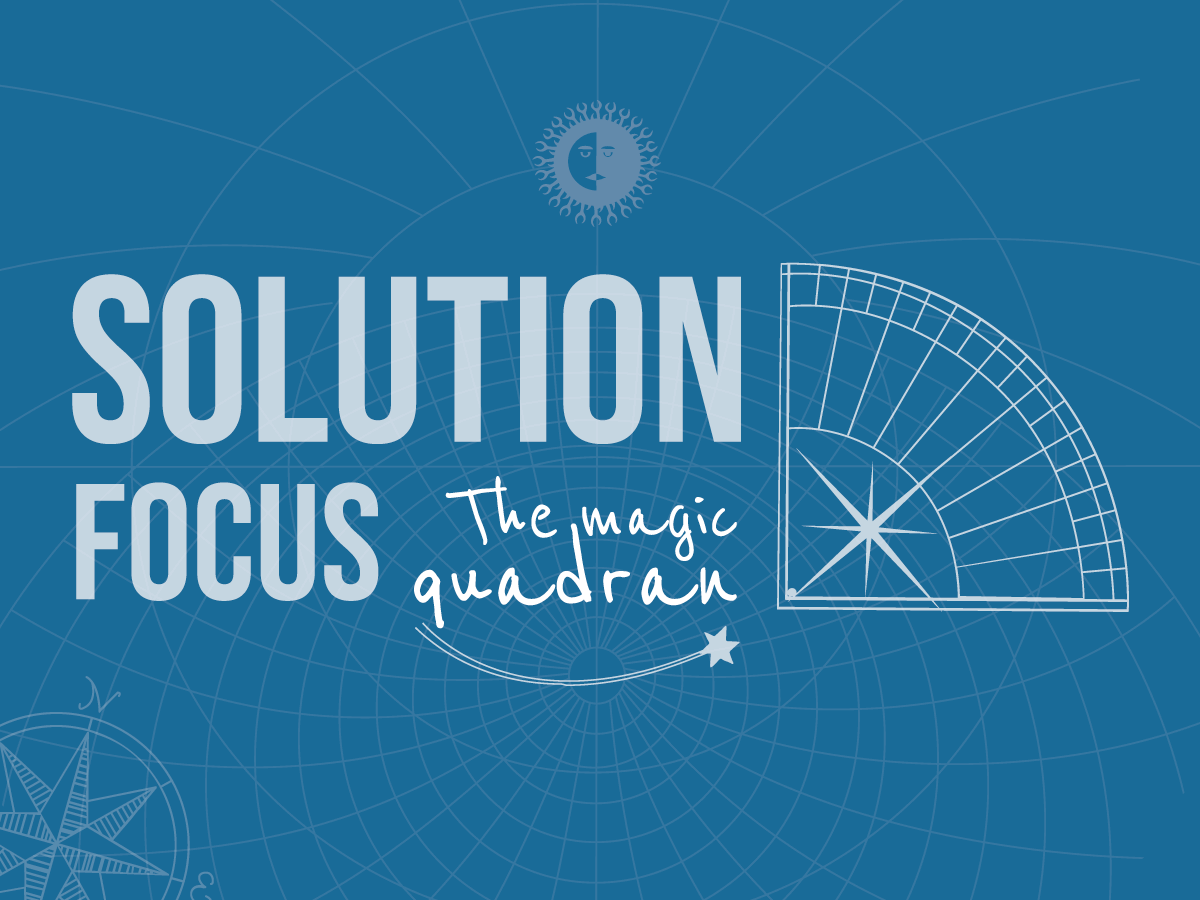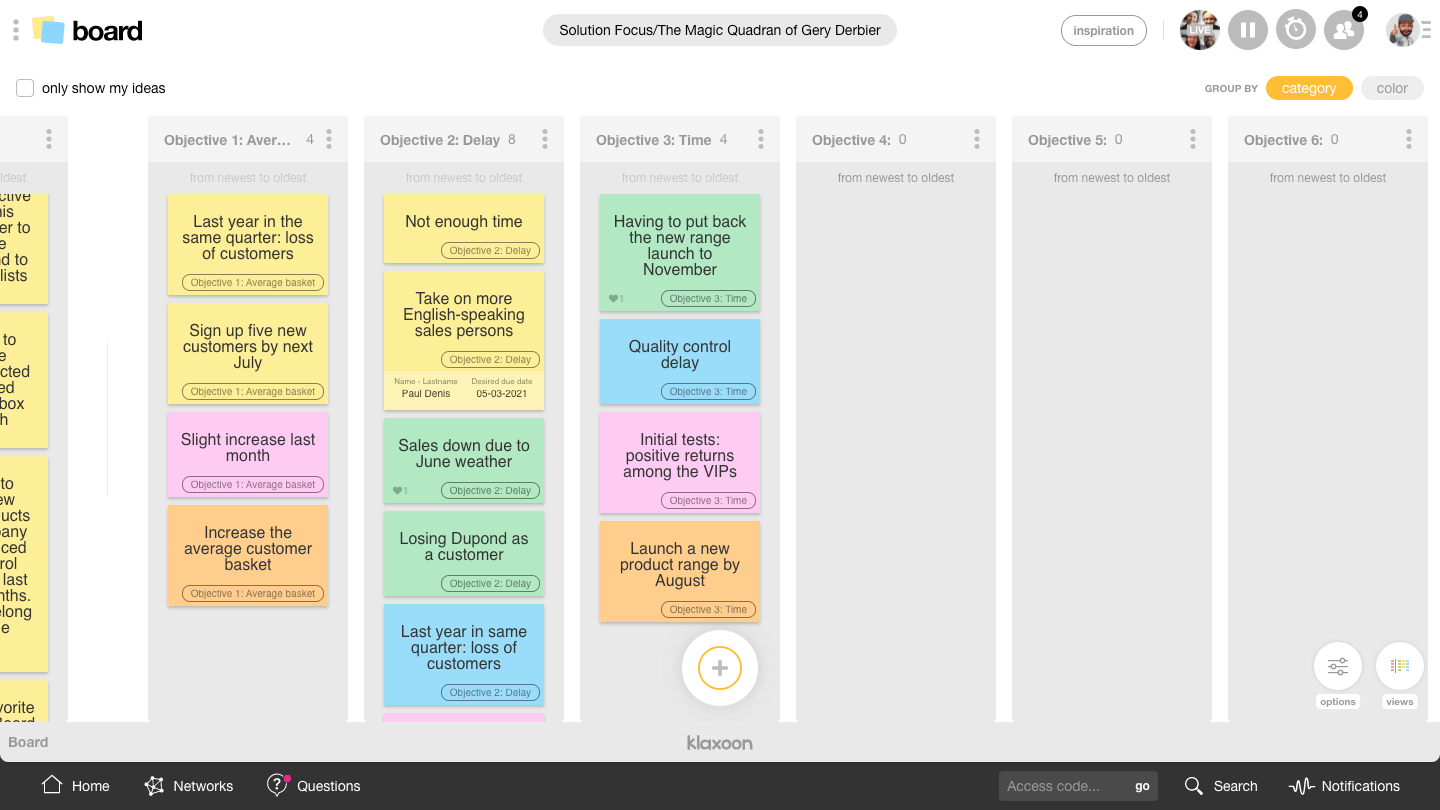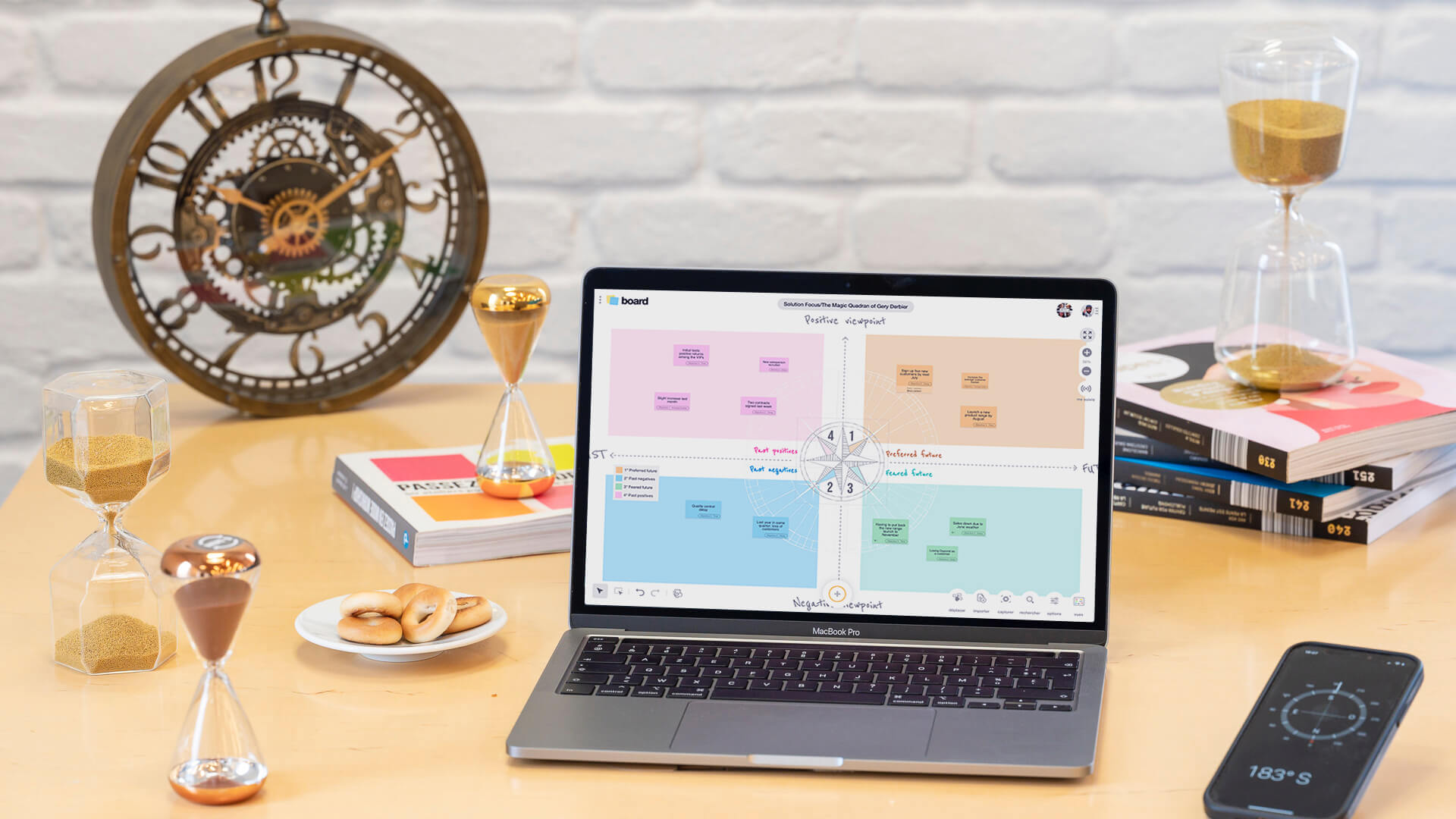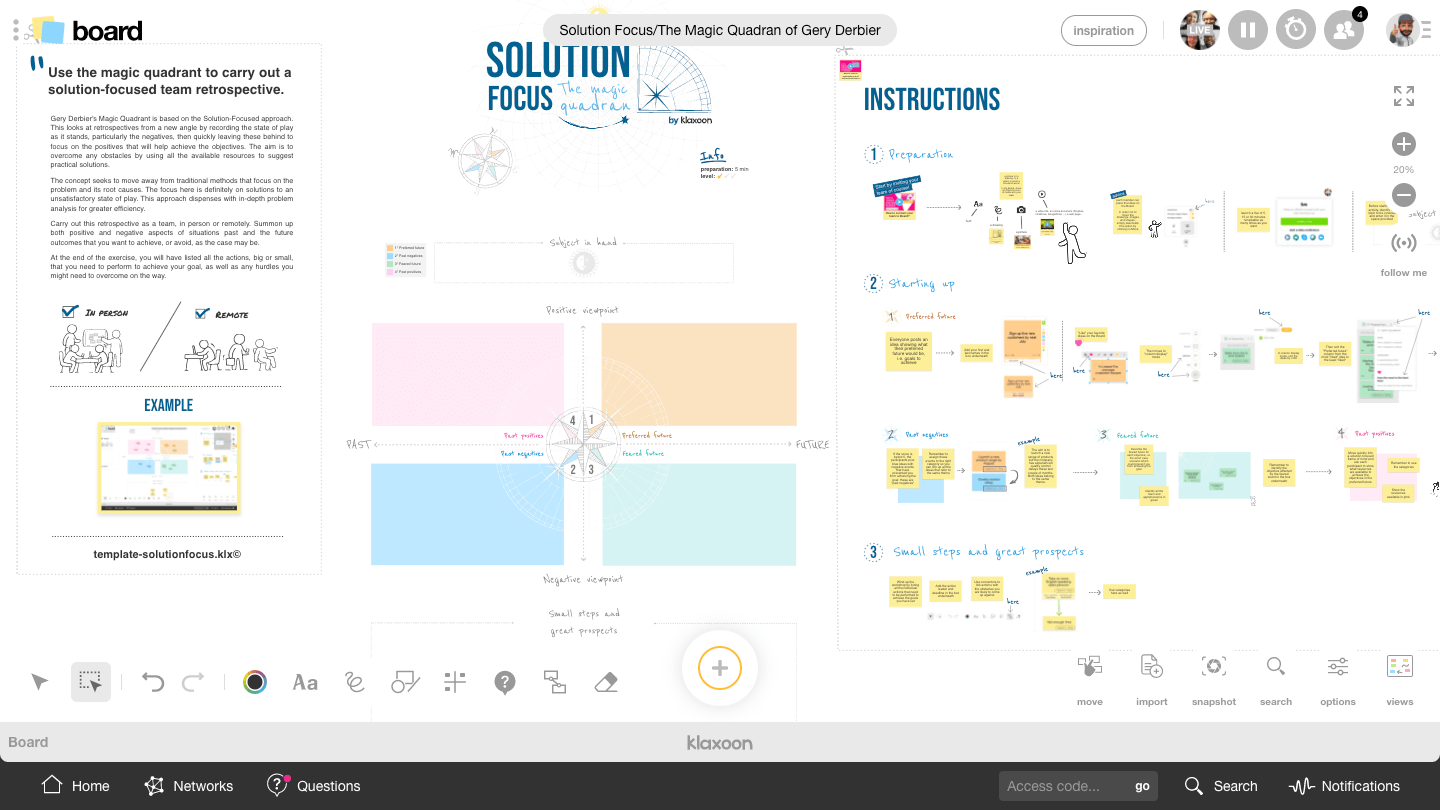Solution Focus: the solution-focused retrospective workshop
Published on February 14, 2025
Solution Focus: the solution-focused retrospective workshop


Use the magic quadrant for a solution-focused teamretrospective. Géry Derbier’s magic quadrant is based on a Solution-Focusedapproach. This looks at retrospectives from a new angle by recording the stateof play as it stands, particularly the negatives, then quickly leaving thesebehind to focus on the positives that will help achieve the objectives. The aimis to overcome any obstacles by using all the available resources to suggest practicalsolutions.
Carry out this retrospective as a team, inperson or remotely. Summon up both positive and negative aspects of situationspast and the future outcomes that you want to achieve, or avoid, as the casemay be. At the end of the exercise, you will have listed all the actions, bigor small, that you need to perform to achieve the required future goal, as wellas any hurdles you might need to overcome on the way.
Well, it looks like the last project didn’t goso well for the team, with everyone complaining, mulling over what went wrong,and passing the buck (tough on poor Alex!). Looks like they’re seeing the glassmore than half empty.
What about seeing that glass half full?
Wait. Why only half full?
With the Solution-Focused method, instead ofonly dwelling on the negatives, focus your analysis on finding solutions to theissues and how you can reach the best possible outcome.
“Will we ever get to work on a project without anyhiccups?”, “It was just one thing after another”, “Alex took us for a ride onceagain!”, “We had to deal with all the teething problems…”
The Solution-Focused approach, currently used for agile processes, was initially used in the medical field. It was developed by two US psychotherapists, Steve de Shazer and Insoo Kim Berg, pioneers in solution-focused brief therapy in the early 1980s.
Traditional therapeutic approaches typically focused on the problems and analyzing the past rather than finding solutions. A new, innovative therapeutic approach emerged. Though it was disruptive at the time, it had solid scientific foundations, with research work showing that dwelling on the past, and mulling over stressful situations fosters negative feelings and conflict. So what’s the point of only analyzing the issues you came up against? Is it not much better to focus on the best way of working around the problem?
This type of behavior is perfectly suited to human relations. The Solution-Focused method uses iteration, i.e. it uses a stepwise approach, relying on what has already worked. Teams are encouraged to identify what can help them reach their objectives in the current context, and to have a positive outlook on the future. Then everyone thinks about how to improve the situation using their own abilities.
Géry Derbier, an agile coach specializing in the Solution-Focused approach, and a firm believer of this thought process, developed an application template, the “Magic Quadrant”, which is ideally suited to teamwork applications.


First of all, you need to determine the subject in hand. Then the workshop takes place in 4 main stages covering the four parts of the quadrant. The time devoted to each part is set by the facilitator and the team.
- Part 1 of the quadrant: your preferred future
Focusing on the subject in hand, the facilitator asks the team to imagine their ideal situation and to describe it in the quadrant’s “preferred future” area. These are in fact the objectives you want to achieve.
Once all the requirements have been listed, the facilitator asks everyone to say where they stand with regard to each preferred future, on a scale of 1 to 5 (1 star means that the person believes the goal is far from being met).
- Part 2 of the quadrant: past negatives
For each “preferred future” (i.e. objective) with a score under 5, the team reflects on the negative reasons leading to this rating, i.e. the past negatives. At this stage, be careful not to point the finger at any team member in particular, as the Solution-Focused approach is meant to be open-minded and optimistic and definitely not a source of conflict (Alex shouldn’t be the team’s scapegoat!).
- Part 3 of the quadrant: the feared future
Everyone imagines potential worst-case scenarios that could hamper their preferred future, i.e. keep them from meeting their objectives. This is when the team’s reservations and concerns are collected.
- Part 4 of the quadrant: past positives
Everyone focuses on available resources that are key to helping them meet their objectives, as well as on the past positives that can make the project a complete success.


To wrap up the workshop, ask everyone to make a list of individual actions they could set up to meet the group’s objectives, and to specify the timeframe. The actions listed may also be implemented as a team. Under a continuous improvement approach, we recommend linking those actions with likely hurdles, which may be completely new or already experienced (those listed in the past negatives area, for example).


For all mixed teams, working remotely or on site, Board Hybrid is the ideal tool for this solution-focused retrospective! Live, the built-in videoconferencing tool, helps communication between team members when some of them can’t work on site.
When you open the specially designed Solution Focus template via Klaxoon’s Board, you access a digital whiteboard, with its unlimited workspace. It features a quadrant divided into 4 areas: preferred future, past negatives, feared future, and past positives, each one identified by a separate color.
Thanks to the color key, the team’s ideas can be easily allocated to either one of the areas. Categories help to add an extra level of information, making it easier to organize each idea according to its objective.
When everyone rates where they stand in relation to the objectives, the facilitator can simply use “Questions”, in particular an assessment-type Question. The objectives are rated on a scale of 1 to 5 stars.
As the stages are completed, the magic quadrant fills up with ideas. Switch to the “Column” display mode to get a different viewpoint and to analyze all the date with filters!
During the wrap-up phase, everyone lists the specific tasks they are to carry out to reach the objective, within the allocated timeframe. These two items of information can be entered in the boxes under the Ideas.
Use Connectors to highlight the relationship between an action designed to meet an objective and a past negative that may once again become a hurdle to overcome.
So next time you run a team project, if you want them to see the glass half full rather than half empty, try the Solution Focus Template!
Browse for other articles and templates on team retrospective workshops tested by Klaxoon’s user community.


Get inspired by other templates from the same categories
Unlock your teamwork potential